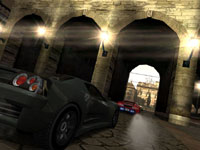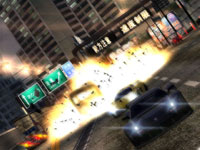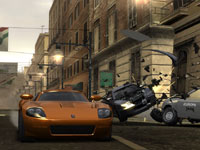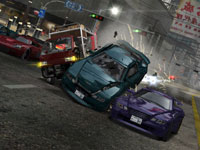

Review: Burnout - Revenge 192
- Title: Burnout: Revenge
- Developer: Criterion Games
- Publisher: Electronic Arts
- System: Xbox (PS2, 360)
- Reviewer: Zonk
- Score: 9/10
Boost is used in a different way in Crash mode, which has seen some significant overhauls. The purpose is still the same: throw yourself into a well-trafficked area with the purpose of destroying as many cars as possible. Upon starting a Crash event the changes are immediately obvious. There is now an acceleration bar that allows you to gain a fast start. A gauge on the bar rises and falls, waiting for you to hit a button. There are two green zones on the bar, and the idea is to hit the button in the middle of the top green zone and again as the gauge falls through the lower of the green zones. If you time it right you'll get a huge burst of speed, and consequently will be able to do that much more damage. While it takes a few tries to get the hang of it, the bar adds some thought to the mindless destruction. Another improvement is the removal of the iconography from Crash mode. While there were once (x3) and ($) symbols hanging in the air, there is now nothing between you and the cars. Scoring big in Crash mode now requires that you use your Crashbreaker on as many cars as possible. The Crashbreaker is an explosive device that goes off after you've passed a set amount of destruction. After a crash your score accrues while your Boost bar fills. Once you've maxed out your Boost bar, a quick tapping mini-game ensues until your Boost overflows. Then the shockwave hits. While before you received multipliers from the icons you hit during the crash, now you gain multipliers for each car affected by the blast. This can result in ludicrously high scores if you detonate in the middle of a large car pile. All these changes add up to a smarter, more entertaining Crash mode.
The other event modes have a lot going for them, too. Road Rage is a modified race that requires you to take down a certain number of cars. Eliminator is an exciting mode that starts like a normal race, with a 30 second timer running on the screen. At the end of the 30 second timer, the lowest ranked car is eliminated. The goal is to be the first place rank at the end of two and half minutes, leaving you the last car standing. Traffic Attack is a fast paced event where you utilize the new traffic check ability to rack up money and carnage. Burning Laps and Preview Races pit you against the clock, and ask you to beat certain times. All of the event modes present interesting challenges, and coupled with interesting track designs results in some extremely entertaining gameplay.Track design in Burnout 3 tended towards atmosphere over innovation. Revenge tracks have all the atmosphere of previous title, but with more thought put into their layout. Tracks now have shortcuts laid running through them, allowing you the chance to cut off some curves and turns by diving between the convenient blue lights marking their entrances. These shave a lot of time off of your laps, and usually go through some interesting places you wouldn't otherwise be able to see from the main track. Courses have verticality to them now as well, with jumps and ramps being a part of the Burnout experience. There's even a new Vertical Takedown reward for managing to slam into someone from above.
Gameplay on the tracks has some new twists as well. Traffic checking is an entertaining activity that allows you to slam into NPC cars from behind and send them flying. Besides getting barriers out of the way, a checked car that flies into an opponent might net you a Takedown. Takedowns lead to the reason behind the word Revenge in the title of the game, as well. In a heated match if an opponent manages to take you out he earns the rival designation, and his marker indicator turns red. Taking out your new rival nets you more Boost than a normal Takedown otherwise would, and after a few Revenge Takedowns you'll start getting more recognition. The additional elements added to the basic gameplay make for a simple element of strategy, as you try to hit your opponents with checked vehicles and specifically target Takedowns at your rival NPCs. Which is more difficult than it used to be, because NPCs have gotten a mental facelift in the past year. They're smarter, and extremely aggressive. At the same time, they've also been given lessons in fairness. One of the frustrations of Burnout 3 was the occasional dead race, where you'd find yourself behind for the entire event because of one mistake early in the first lap. In a title like Burnout, which emphasizes collisions and entertainment over simulation, that was extremely frustrating. The opponents in Revenge are aggressive racers, but you'll never find yourself completely out of the pack. Races are always hard won, with the other racers making you earn every event you conquer.
All of these event modes come together in the World Tour, which is a trimmed down version of the three-map interface in Burnout 3. All events are gathered together under a certain rank designator. Your rank starts at 1, and as you complete events with varying medals you accrue stars towards higher ranks. Collect enough stars, and you move up to the next rank. Within each rank is a group of locations, and at each location is a series of events. Events can be run backwards or forwards, so you may find yourself running on a particular track several times over the course of a rank, each time doing a different event or going a different direction. As events are successfully completed, you earn higher ranks and unlock content within the game. New events are unlocked through your success, as are new vehicles, trophies, and mementoes of spectacular moves you've made. The feeling of movement and accomplishment on the track is transferred to the game's framework, as you move up in ranks and add notches in your belt.
The feeling of movement on the track is intense, and largely thanks to the graphical presentation of the title. Burnout is all about speed, and the game is very convincing in that department. Blurring, tumbling cars, streaking scenery, and violent explosions all convey the rate of movement the game is aiming for. The sense of speed most racers want to get across sometimes falls flat, and the success of Burnout: Revenge is a high mark to shoot for. The cars themselves are beautifully rendered, with reflections sliding around and off of the vehicle's lines. The signature bullet-time like effect called Impact Time utilized during a crash has been enhanced to provide a movie quality effect when you screw up. Burnout: Revenge is a gorgeous looking game, and pushes the limits of this generation of consoles. There are surprisingly few slowdowns, and I didn't have any problems with interrupted play because of a technical glitch. The only issue I ran across seemed to be related to loading objects into the gamespace. There is a crash mode event that puts you at the top of a hill on a two lane road with traffic in both directions. Once or twice I managed to slam into an invisible truck that had yet to be visible within the game, but whose collision detection caused me to lose before I'd barely begun. Aside from that quirk, the game is a smooth, beautiful experience to behold.Revenge is also pleasant to listen to. The game's sound effects backup the sense of speed that the visuals portray, with revving engines, squealing tires, and grinding metal placing you squarely in the moment. The soundtrack has shared elements with Burnout 3, the popular music of today headlining with a slightly more metal edge than the pop-flavoured tunes of the previous game. To be honest, after an hour or two listening to the game's default soundtrack I started using the custom soundtrack feature. E.S. Posthumus's "Unearthed" is surprisingly appropriate for epic racing and car crashes. Thankfully, the most annoying aspect of Burnout 3's soundscape has been removed. There is no DJ radio announcer in the game. A woman's voice welcoming you to the game and giving you instructions during tutorials is the only voice-over work you'll have to deal with.
Burnout: Revenge is the fourth chapter in the series, and looks to be shaping up as another yearly EA release alongside Madden. While this game may not be innovative or indie, it's hard to argue with the sheer amount of fun you can have playing this game. The latest title in the Burnout line manages to capture the best parts of the previous games while adding on new elements, polishing the gameplay to a razor sharpness. The speed, the energy, and the variety of different ways to play will ensure that you'll have a hard time putting this title down. Multiplayer capability, in the form of split-screen and Xbox Live competition, is solid and engaging as well. In all truth, this game can hardly be called a racing game. It's a beautifully fun excuse to go fast and blow things up, and if you enjoy either of those activities you'll be hard pressed to pass this title by.





Load times? (Score:3, Informative)
A Dissenting View (Score:5, Informative)
Crash mode - In B3, Crash mode was like a puzzle on speed. Finding those x3 and x4 tags and figuring how to hit them while still causing a pileup was the goal. Now the goal is more like Dance Dance Revolution (time that start correctly) followed by Microsoft Olympics (mash that B button like a monkey on meth to make the explosion happen) Driving? not really that important. Placement of wreck? important, but if you fail on the other two "skill" tests, it won't matter.
Car checking - There's now very little danger in driving on the proper side of the road. Anything you hit that is smaller than you and travelling in the same direction just bounces out of the way, barely slowing you down, adds an interesting play mechanic, but takes some of the skill out driving some of those courses. Also, it's applied a little strangely, as cross traffic still causes crashes... sometimes.
Finally, it's no longer good enough to just get a gold medal on each event in the game, you also have to get a gold medal while being "stylish" enough doing it.
It's a good game, certainly, but I prefer B3. I'd only give B4 a 6 or 7 out of 10.
Re:Screenshots (Score:1, Informative)
Re:A Dissenting View (Score:3, Informative)
I also really like the addition of wind drift, and the weight factor of various vehicles, something I really don't remember from B3.
I agree the glitches with sometimes checking not working quite as expected oughta be fixed, but overall I find that element to be a lot more fun than the way it was in B3. Games like this aren't about weaving through traffic, and the developers recognized that and heightened the smash-shit-up quotient. I personally play B:R to relax, and nothing relaxes me like checking traffic all over the place.
Thats just not true. Winning a gold on an event gives you an automatic five star rating, thats the beauty of it. Just like winning a bronze automatically deducts a star.Re:Load times? (Score:2, Informative)
Worth owning but only just (Score:4, Informative)
The revamp of crash mode is fun but also broken. First off, the launch is stupid
The new environments for crash mode partially upset this, as well as the wider selection of vehicles. The fun part of crash mode now is finding both the right path and the right vehicle
What's dissapointing is that there's no longer a crash replay! That makes it harder to determine how to "improve" your rating since you see just the aftermath of your run, rather than the run itself. And the target car is silly, since it is almost guaranteed to be involved in any reasonably sized crash. Additionally, it would be nice if two vital statistics were displayed at the end of the crash in addition to dollar damage: number of cars wrecked and explosion multiplier. These can be dug out with a few button presees, but they are critical to levelling up and should simply be displayed.
A side note: you can see the hand of the developers clearly in crash mode; not only do cars NOT try to avoid crashes, but you can see cars hit a "radius of control" at which point they accelerate into the crash. Despite this, the physics of crash mode is improved in many subtle ways. Cars tend to twist and roll in a much more realistic manner.
In terms of new things that are broke, being able to rear-end cars is a total mistake. It randomizes the races, since you just plow through traffic, with your vision obscured by the vehicles you've slammed ahead of you, until eventually you hit a bus or wall. It's very common, because of this (and shortcuts) to see you position shift constantly between first and last. When I first heard about this feature, I assumed you'd be able to side-check, not rear-end, vehicles
Opponents do not avoid you as well during aftertouch; it's much easier to score an aftertouch takedown in Burnout Revenge than in Burnout 3, but it's much harder to score an ordinary takedown. "Psyche-out" takedown are even more rare.
The new race crashbreakers (the ability to explode when taken out) are generally a good idea; you have to be tactical about them, since detonating without taking out an opponent leaves you with no boost at all. However, your opponents do NOT have this ability
The "stars" system is another broken change. Despite the fun feedback you get during a race for reaching new levels ("OK", "Good", "Awesome")
The 10 levels of unlocking progression is more confusing and less satisfying than Burnout 3's approach of unlocking classes of cars. You unlock a huge number of cars, sometimes it feels like one per race. The cars are all fast (many blindingly fast) but run together as well, the names are less memorable than Burnout 3's, and all seem to handle the same. The differentiation between cars (outside of top speed) is even less in Burnout Rev
Re:Screenshots (Score:3, Informative)
Re:What needs to change? (Score:3, Informative)